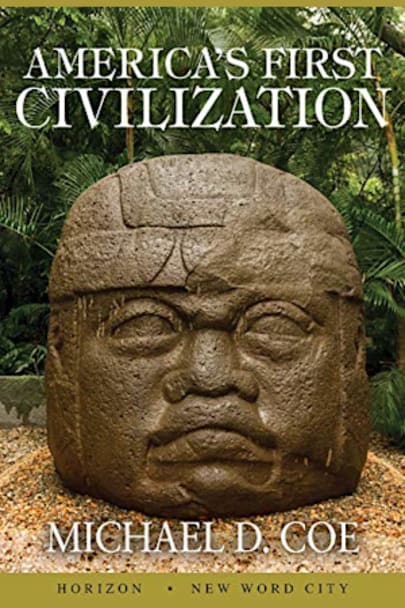Here is the story of America’s oldest – and oddest – civilization, the Olmecs of the southern Mexican jungles. Virtually unknown to archaeologists until the early twentieth century, their true importance is only now being realized and shedding new light on how the Indian peoples of the Americas came to be here.



This is not a book one is likely to snuggle up with while enjoying their favorite libation. It is however fascinating if at times dry and only of interest for a few who may ponder our past. It certainly leaves one questioning “how’d they do that”? Numerous monuments throughout history remain unexplained, or at least guessed at and maybe you buy it maybe not. Stonehenge, Easter Island, the Pyramids in Egypt. But in our own hemisphere there are also wonders to discover. The Olmecs appeared around 3,000 years ago, or 1,000 years BCE. They were indeed civilized albeit primitive. Seems like an oxymoron, but consider. They mined 18 ton stones, transported them some 60 miles and carved giant heads as monuments to some unknown. They dug holes approximately 20 feet deep, about 20 feet square, lined the bottom with carved slabs and then covered the same with the dirt they had removed. They built a pyramid 100 feet high with layers of different colored clay, the source of which is unknown. They were big on jade carvings. Essentially, they selectively bred crops to establish an agricultural food source. Yet no one knows from where they came. It may be assumed as they died out the Mayas, the Aztecs, the Incas, and some other advanced peoples came to be. While much of history seems to focus on early Europe, the Mideast and Asia, there is much to ponder about the history here in the Americas. A book that will leave you if not in awe at least wondering.
Always thought the Olmecs were very mysterious. Turns out they were quite similar to the Aztecs and Mayans in their religious practices. The author doesn’t quite solve the enigma of their origins but it’s very interesting reading. A civilization springs up right next to hunter-gatherers. So odd
Excellent summary of the relationships of indigenous Mexican civilizations, with the Olmec as the foundation. Very detailed and up to date on Olmec origins, culture and art. Leaves you hungry for more.
Author Michael Coe writes from firsthand knowledge—he excavated at San Lorenzo and the difficulties he faced including native peoples who were in no mood to have outsiders snooping about their domain, millions of ticks, snakes and other assorted vermin that thrive in the hot, wet southern terrain of Mexico. You get a real sense of the difficulties that no movie or TV program can effectively convey.
Mostly interesting book about a curious disappeared civilization, but gets dry at times.
This book comes across as a would be text book author’s attempt at writing a story about the earliest inhabitants of the Americas. If you like text books you will like it. If you don’t then it will come across as dull, dry and something you were assigned to read.
Excellent detail on the discoveries related to a little known subject, but somewhat of a slow and plodding read.
Amazing information that greatly broadened my knowledge.
This is an interesting book but a relatively dry read due to the academic nature of the subject matter. It has much to interest the historian, the archeologist, sociologist and anthropologist.
As I enjoy such fields of study, it was good for me and I like the book. That said, it clearly would not be as pleasurable to folks looking for an entertaining read.
This is modern historical information about ancient civilizations we are just discovering in the Americas.
I knew nothing about the Olmecs or about the history of Mexican or Mesoamerican civilizations prior to the Aztecs and Mayans. Very interesting, very informative.
Interesting and fascinating well written with exception of a few unnecessarily complex sentences would have been. 5 star with images
And maps
Well researched history of the Olmec culture.
Needs more in-depth explanations on the method used to determine the hypotheses arrived at regarding a race that is no longer viable.
Very interesting about the early civilizations of South America. Really need pictures and maps to make it really good
This was an interesting read.
poorly written
Not a page turner, but as non-fiction history books go, it was pretty good. Interesting and informative.
History fascinates me and I was hoping to learn much more from this book than I actually did. It could have been condensed into an essay and all the information would have fit nicely. The premise is that the Olmec were first among the Mesoamerican cultures. Beyond that there is some data about how to date findings most accurately and details about how to handle archaeological digs. Don’t get your hopes up if you are looking for much more.
The information was interesting but the book lacks maps and photos that really needed to be included.